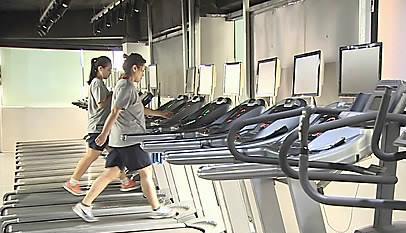- California Assembly OKs highest minimum wage in nation
- S. Korea unveils first graphic cigarette warnings
- US joins with South Korea, Japan in bid to deter North Korea
- LPGA golfer Chun In-gee finally back in action
- S. Korea won’t be top seed in final World Cup qualification round
- US men’s soccer misses 2nd straight Olympics
- US back on track in qualifying with 4-0 win over Guatemala
- High-intensity workout injuries spawn cottage industry
- CDC expands range of Zika mosquitoes into parts of Northeast
- Who knew? ‘The Walking Dead’ is helping families connect
One-third of S. Koreans overweight, many not trying to slim down: data
SEOUL (Yonhap) — Roughly a third of adult South Koreans were overweight in 2014, with many not even trying to lose weight, government data showed Monday.
The 2014 national health data by the Korea Centers for Disease Control and Prevention (KCDC) showed 31.5 percent of people over 19 were categorized as being obese, with a body mass index (BMI) of 25 kilograms per square meter or more.
BMI takes into account weight, height and body fat of an individual.
Of overweight people, 63.5 percent took steps to become slimmer, but 36.5 percent did not even make an effort to go on a diet or exercise.
The findings based on a survey of more than 5,000 people nationwide, showed 71 percent of overweight women tried to lose weight, while the corresponding number for men stood at 60 percent.
“Women made more efforts to lose weight than men, with young women in their late teens, 20s and 30s being more aggressive,” the KCDC said. In contrast, men in their 30s and 60s generally did much less to lose weight.
The center said that one reason for people not trying to lose weight can be found in perception. One in 7 overweight people in the country did not think they were fat, it said.
The data also showed that income levels impacted whether a person is obese or trim, with gender and age playing a part.
The likelihood of a man being overweight stood at 37.7 percent overall, much higher than 25.3 percent for women. While numbers for men were relatively uniform across income levels, women who made less tended to be fatter.
Among women in the lowest income bracket, 26.6 percent were overweight, while this dipped to 25.3 percent and 23.4 percent, respectively, for middle and middle-upper income earners. The number further fell to 18.3 percent for women with high income.
In contrast, 43.2 percent of men in the middle-lower income bracket were fat, but 34.1 percent of men making high incomes were overweight as well. Among men in other income groups, the percentage of overweight people stood around the mid-30 percent range.
The latest data, meanwhile, showed that on average, a South Korean remained seated for 7.5 hours per day and slept 6.8 hours.
Time spent on sedentary activities reached 8.7 hours for people between the ages of 19 to 29, and gradually fell to 6.7 hours for people in their 60s, before rising again to 7.5 hours for senior citizens over 70.
Urban dwellers spent more time seated than those living in rural areas. High income earners stayed more rooted to their seats than low income earners.
The average time that people slept stood at 7.1 hours for people under 29, with this number falling to 6.8 hours for people in their 30s and 40s, and dipping further to 6.7 hours and 6.6 hours for those in their 50s and 60s, according to the data.

















Pingback: 19 Hour Diet | Herbal Diet